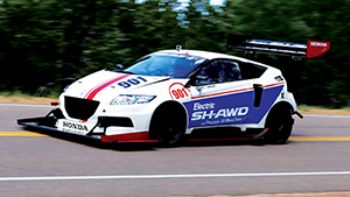
The recent Tokyo Motor Show saw the expected focus on ‘green’ automotive technology, giving an indication of where the major manufacturers are focusing ‘engine’ development in a world that is increasingly aware of the effects of CO2 emissions on global warming and NOx on human health; and while the conventional internal combustion engine still has not reached the end of its life, it seems inevitable that the increasing emphasis on electronics will be to the detriment of the massive number of ‘mechanical’ parts in the typical power plant of today.
For example, Lexus put its stamp on hydrogen fuel cells as a form of motive power with the introduction of its LF-FC — Lexus Future-Fuel Cell — concept car. This uses a hydrogen fuel cell to directly power the rear wheels, while also sending power to the two in-wheel electric motors at the front of the car — a configuration that Lexus says allows it to “precisely distribute torque to all four wheels”.
Meanwhile, Honda (world.honda.com) launched its latest hydrogen-fuelled car — the FCV Clarity; and of particular interest is the fact that the new vehicle’s fuel cell stack is considerably smaller than its predecessor in the FCX Clarity — by a third. This means it can be fitted under the bonnet, as with a conventional engine; and packaging like this opens up a lot of possibilities with regard to its application in a number of car styles.
With this latest drive system, Honda engineers addressed owners’ biggest concern — that of range. While the FCX Clarity managed 240 miles in a recognised test cycle, the FCV achieves more than 300 miles — and it is reckoned that it could better 400 miles in many ‘real world’ situations. Moreover, as well as being considerably more compact than the previous fuel cell stack, the latest one cost 90% less to produce. Energy is stored in a lithium-ion battery, and the fuel cell has a nominal output of 134bhp. Toyota also unveiled a new hydrogen fuel cell-powered concept car. Moreover, its FCV Plus can generate electricity when not being used, providing power for use at home or away.
Pushing the boundaries of electric power, Honda proved its prowess at this year’s Pikes Peak hill climb event in Colorado (USA), where cars and motorcycles race to the summit; the track is 12.42 miles long, has 156 turns, and climbs from 4,720ft to 14,110ft. The system Honda used was based on the technology developed for its SH-AWD electric NSX, which has an electric motor on each front wheel and a third one driving the rear axle. However, Honda used the technology developed for the NSX but paired a 50kWhr battery with electric motors on all four wheels to produce a successful Pikes Peaks racer producing 444bhp (pictured left).
Honda is reported to be considering a de-tuned production version of this car. It is reckoned that this will be rated at 345bhp and have a range of 250 miles. Furthermore, a road-going prototype of this car exists. Honda’s president, Takahiro Hachigo, says he has driven the ‘four-motor’ CR-Z and would like to see it mass-produced.
While travelling distance is highlighted as a concern for electric vehicles, Nissan says that its IDS Concept, a battery-powered five-door vehicle, breaks ground on two fronts: its autonomous abilities, and its ability to travel long distances on a single charge.
In conventional driving mode, the driver has control and a screen-based instrument panel; in ‘piloted’ mode, the steering wheel folds away and the seats turn towards one another (to facilitate conversation, says Nissan). While not being specific about the vehicle’s range, Nissan engineers say that “the combination of good aerodynamics, lightness and a new high-capacity 60kWhr battery will allow the IDS to cover long distances”.
Making its entrance to the four-wheeled market was Yamaha, a company probably best known for its motorcycles (the company recently won the 2015 Moto GP). The Tokyo show saw the company reveal its Sports Ride, a concept car based on the input of British designer Gordon Murray. This uses a variation of the designer’s iStream production process, but instead of the original glass-fibre construction, the car uses carbon fibre, which gives it lightness and strength. Designer Akihiro Dezi Nagaya said that Yamaha was looking to integrate as much as possible of its motorcycle heritage into the concept of the new car, with some engines that could be used topping 150bhp (although some of its bikes get near to 200bhp).
Prominent on the Mazda stand was the RX-Vision — a car that confirms the company’s intention to launch a new range-topping sports-car powered by a rotary engine. Its most recent rotary model — the RX-8 — was last sold in 2012. While rotary engines for mainstream automotive applications have gone out of favour of late, Mazda aims to see them make a comeback.
The RX-Vision housed an all-new rotary engine called the Skyactiv-R, which was said to address the three key issues associated with rotary engines, namely: fuel economy, emissions and reliability. It is expected that the new engine will develop some 300bhp; it has also been suggested that turbo-charging is under investigation, as is ‘hybridisation’ (although this would present considerable challenges). It is possible that the car, likely to be known as the RX-7, could be available in 2017 — 50 years after Mazda displayed the first rotary-engine production car.